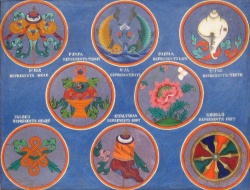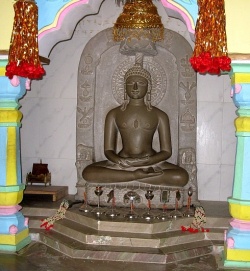Ashtamangala
Ashtamangala (Sanskrit: अष्टमंगल Aṣṭamaṅgala, Tibetan: བཀྲ་ཤིས་རྟགས་བརྒྱད, Wylie: bkra shis rtags brgyad, ZYPY: Zhaxi Dag'gyä, Lhasa dialect IPA: [tʂáɕitaʔ cɛ̀ʔ]); Chinese: 吉祥八宝 Jíxiáng bā bǎo) are a sacred suite of Eight Auspicious Signs endemic to a number of Indian religions such as Hinduism, Jainism, and Buddhism. The symbols or "symbolic attributes" (Tibetan: ཕྱག་མཚན།, Wylie: phyag-mtshan) are yidam and teaching tools. Not only do these attributes, these energetic signatures, point to qualities of enlightened Mindstream, but they are the investiture that ornaments these enlightened "qualities" (Sanskrit: guṇa; Tibetan: ཡོན་ཏན, Wylie: yon tan). Many cultural enumerations and variations of the Ashtamangala are extant.
- Groupings of Eight auspicious symbols were originally used in India at ceremonies such as an investiture or coronation of a king. An early grouping of symbols included: throne, swastika, handprint, hooked knot, vase of jewels, water libation flask, pair of fishes, lidded bowl. In Buddhism, these eight symbols of good fortune represent the offerings made by the gods to Shakyamuni Buddha immediately after he gained Enlightenment.
In Buddhism
Tibetan Buddhists make use of a particular set of Eight auspicious symbols, ashtamangala, in household and public Art. Some common interpretations are given along with each symbol although different teachers may give different interpretations:
Conch
The right-turning white Conch shell (Sanskrit: Śaṅkha; Tibetan: དུང་གྱས་འཁྱིལ, Wylie: dung gyas 'khyil), representing the beautiful, deep, melodious, interpenetrating and pervasive sound of the Buddhadharma, which awakens disciples from the deep slumber of Ignorance and urges them to accomplish their own welfare and the welfare of others;
In Hinduism the Conch is an attribute of Vishnu as is the Wheel (Sudarshana). Vaishnavism holds that Shakyamuni Buddha is an Avatar of Vishnu.
- The Conch shell is thought to have been the original horn-trumpet; ancient Indian mythical epics relate heroes carrying Conc shells. The Indian God Vishnu is also described as having a Conch shell as one of his main emblems; his shell bore the name Panchajanya meaning "having control over the five classes of beings".
Knot
The Endless knot or eternal knot (Devanagari: श्रीवत्स; Sanskrit: śrīvatsa; Tibetan: དཔལ་བེའུ, Wylie: dpal be'u) as Chandra et al. (1902: p. 69) state denotes "the auspicious mark represented by a curled noose emblematical of Love". Moreover, it represents the intertwining of Wisdom and Compassion, the mutual dependence of religious Doctrine and secular affairs, the union of Wisdom and method, the inseparability of emptiness and dependent co-arising), and the union of Wisdom and Compassion in Enlightenment. It is also symbolic of knot symbolism in linking ancestors and omnipresence and the magical ritual and meta-process of binding (refer etymology of Tantra, Yoga and religion) (see Namkha). This knot/net/web metaphor also conveys the Buddhist teaching of the Doctrine of Interpenetration.
Fish
The two goldfish (Sanskrit: Gaur-matsya; Tibetan: གསེར་ཉ, Wylie: gser nya ), representing the state of fearless suspension in a harmless ocean of Samsara, metaphorically often refer to Buddha-eyes or rigpa-sight; symbolises the auspiciousness of all Sentient beings in a state of fearlessness without danger of drowning in the Samsaric Ocean of Suffering, and migrating from place to place and teaching to teaching freely and spontaneously just as fish swim freely without fear through water;
In the following quotation, the two golden fishes are linked with the Ganges and Yamuna, and nadi, prana and carp:
- The two fishes originally represented the two main sacred rivers of India - the Ganges and Yamuna. These rivers are associated with the lunar and solar channels, which originate in the nostrils and carry the alternating rhythms of Breath or prana. They have religious significance in Hindu, Jain and Buddhist traditions but also in Christianity (the sign of the fish, the feeding of the five thousand). In Buddhism, the fish symbolize Happiness as they have complete freedom of movement in the water. They represent fertility and abundance. Often drawn in the form of carp, which are regarded in the Orient as sacred on account of their elegant Beauty, size, and Life-span.
Lotus
The Lotus flower (Sanskrit: Padma; Tibetan: པད་མེ, Wylie: pad ma), representing "primordial purity" (Tibetan: ཀ་དག, Wylie: ka dag) of Body, speech, and mind, floating above the muddy waters of attachment and desire; represents the full blossoming of wholesome deeds in blissful liberation.
Parasol
The jewelled parasol (Sanskrit: chhatraratna; Devanagari: छत्ररत्न; Tibetan: རིནཆེན་གདུགས, Wylie: rin chen gdugs) or Sacred Umbrella, which is similar in ritual function to the baldachin or canopy. Müller-Ebeling, Rätsch & Shahi (2002) scholarly chart the origins of the Sacred Parasol as a symbolic depiction of sacred medicinal and hallucinogenic mushrooms of the Himalayan pharmacopeia; representing the protection of beings from harmful forces, illness; represents the canopy or firmament of the sky and therefore the expansiveness and unfolding of space and the element æther; represents the expansiveness, unfolding and protective quality of the sahasrara; under the auspice of the precious parasol all take Refuge in the Dharma.
Urn

The treasure vase or Urn of Wisdom (Tibetan: བུམ་པ, Wylie: bum pa) represents health, longevity, wealth, prosperity, Wisdom and the phenomenon of space. Indeed, to disambiguate, "Space" (Sanskrit: ākāśa) is a rendering of the particular denotation of the element of the Mahabhuta (Sanskrit; English: "Great Elements") and the Five Pure Lights. Space is that elemental matrix that contains, holds, and conducts all phenomena. Space is the repository and conduit of everything that is manifest, embodied or incarnate; symbolises Śūnyatā (Sanskrit); the iconographic representation of the 'Wisdom urn' is often very similar to the 'water pot' (Sanskrit: Kumbha), which is one of the few allowable possessions of a Theravadin Bhikku or Bhikkuni; the Wisdom urn or treasure vase is used in many Vajrayana empowerments and initiations;
Wheel
The Wheel of Law (Sanskrit: Dharmacakra; Tibetan: ཁོར་ལོ, Wylie: khor lo), sometimes represents Sakyamuni Buddha and the Dharma teaching, and also represents the mandala and chakra. This symbol is commonly used by Tibetan Buddhists, where it sometimes also includes an inner wheel of the Gankyil (Tibetan). Nepalese Buddhists don't use the Wheel of Law in the Eight auspicious symbols.
Instead of the Dharma wheel, A Fly Whisk may be used as one of the ashtamangala to symbolize Tantric manifestations. It is made of a yak's tail attached to a silver staff, and used in ritual recitation and during fanning the deities in an auspicious religious ceremony (puja) The Mani wheel is another Dharmacakra guise that unites the function of the yak's tail with the doctrinal aspect of the Wheel of Law. The Sudarshana Chakra is a Hindu wheel-symbol.
Victory Banner
Dhvaja (Skt. also Dhwaja; Tibetan: རྒྱལ་མཚན, Wylie: rgyal mtshan), meaning banner or flag. Dhvaja banner was a military standard of ancient Indian warfare. Makara Dhvaja has become latter an emblem of the Vedic God of Love and desire — Kamadeva. Within the Tibetan tradition a list of eleven different forms of the victory banner is given to represent eleven specific methods for overcoming defilements. Many variations of the dhvaja's design can be seen on the roofs of Tibetan monasteries to symbolyze The Buddha's victory over four maras.
Sequences of symbols
Different traditions order the eight symbols differently.
Here is the sequential order of the Eight auspicious symbols of Nepali Buddhism:
- Endless knot
- Lotus flower
- Victory Banner
- Wheel of Dharma or Chamaru in Nepali Buddhism * Treasure Vase
- Golden Fish pair
- Parasol
- Conch shell
The sequential order for Chinese Buddhism was defined in the Qing Dynasty as:
- Wheel of Dharma
- Conch shell
- Victory Banner
- Parasol
- Lotus flower
- Treasure Vase
- Golden Fish pair
- Endless knot
Hindu symbols
In Indian and Hindu tradition, the Ashtamangala may be used during certain occasions including: pujas, weddings (of Hindus), and coronations. The ashtamangala finds wide mention in the texts associated with Hinduism, Buddhism, and Jainism. They have been depicted in decorative motifs and cultural artifacts.
- The North Indian tradition lists them as:
- The South Indian tradition lists them as:
- The list also differs depending on the place, region, and the social groups.
Jain symbols
In Jainism too, the Ashtamangala are a set of Eight auspicious symbols. There is some variation among different traditions concerning the eight symbols.
In the Digambara tradition, the eight symbols are:
- Parasol (Chhatraratna)
- Banner (Dhvaja)
- Vessel (Kalasha)
- Whisk (Chauri)
- Mirror (Darpana)
- Seat (Sukhasana)
- Fan
- Vessel
In the Svetambara tradition, the eight symbols are:
- Swastika
- Sri Vatsa
- Nandavarta
- Vardhmanaka (Food vessel)
- Bhadrasana (seat)
- Kalasha (pot)
- Darpan (mirror)
- Meen Yugala (pair of fish)








